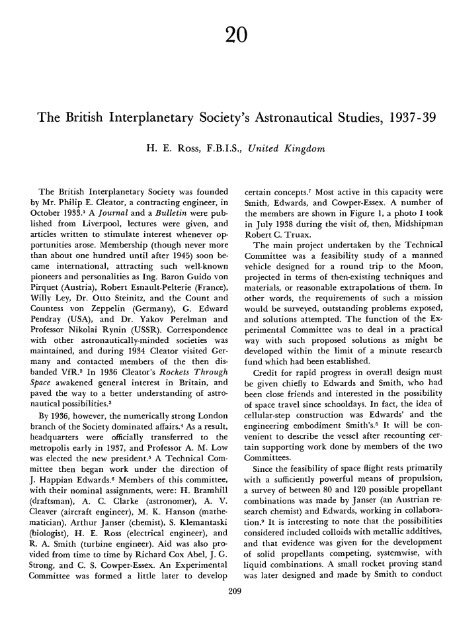FIRST STEPS TOWARD SPACE - Smithsonian Institution Libraries
FIRST STEPS TOWARD SPACE - Smithsonian Institution Libraries
FIRST STEPS TOWARD SPACE - Smithsonian Institution Libraries
You also want an ePaper? Increase the reach of your titles
YUMPU automatically turns print PDFs into web optimized ePapers that Google loves.
20<br />
The British Interplanetary Society's Astronautical Studies, 1937-39<br />
The British Interplanetary Society was founded<br />
by Mr. Philip E. Cleator, a contracting engineer, in<br />
October 1933.* A Journal and a Bulletin were published<br />
from Liverpool, lectures were given, and<br />
articles written to stimulate interest whenever opportunities<br />
arose. Membership (though never more<br />
than about one hundred until after 1945) soon became<br />
international, attracting such well-known<br />
pioneers and personalities as Ing. Baron Guido von<br />
Pirquet (Austria), Robert Esnault-Pelterie (France),<br />
Willy Ley, Dr. Otto Steinitz, and the Count and<br />
Countess von Zeppelin (Germany), G. Edward<br />
Pendray (USA), and Dr. Yakov Perelman and<br />
Professor Nikolai Rynin (USSR). Correspondence<br />
with other astronautically-minded societies was<br />
maintained, and during 1934 Cleator visited Germany<br />
and contacted members of the then disbanded<br />
VfR. 2 In 1936 Cleator's Rockets Through<br />
Space awakened general interest in Britain, and<br />
paved the way to a better understanding of astronautical<br />
possibilities. 3<br />
By 1936, however, the numerically strong London<br />
branch of the Society dominated affairs. 4 As a result,<br />
headquarters were officially transferred to the<br />
metropolis early in 1937, and Professor A. M. Low<br />
was elected the new president. 5 A Technical Committee<br />
then began work under the direction of<br />
J. Happian Edwards. 6 Members of this committee,<br />
with their nominal assignments, were: H. Bramhill<br />
(draftsman), A. C. Clarke (astronomer), A. V.<br />
Cleaver (aircraft engineer), M. K. Hanson (mathematician),<br />
Arthur Janser (chemist), S. Klemantaski<br />
(biologist), H. E. Ross (electrical engineer), and<br />
R. A. Smith (turbine engineer). Aid was also provided<br />
from time to time by Richard Cox Abel, J. G.<br />
Strong, and C. S. Cowper-Essex. An Experimental<br />
Committee was formed a little later to develop<br />
H. E. Ross, F.B.I.S., United Kingdom<br />
209<br />
certain concepts. 7 Most active in this capacity were<br />
Smith, Edwards, and Cowper-Essex. A number of<br />
the members are shown in Figure 1, a photo I took<br />
in July 1938 during the visit of, then, Midshipman<br />
Robert C. Truax.<br />
The main project undertaken by the Technical<br />
Committee was a feasibility study of a manned<br />
vehicle designed for a round trip to the Moon,<br />
projected in terms of then-existing techniques and<br />
materials, or reasonable extrapolations of them. In<br />
other words, the requirements of such a mission<br />
would be surveyed, outstanding problems exposed,<br />
and solutions attempted. The function of the Experimental<br />
Committee was to deal in a practical<br />
way with such proposed solutions as might be<br />
developed within the limit of a minute research<br />
fund which had been established.<br />
Credit for rapid progress in overall design must<br />
be given chiefly to Edwards and Smith, who had<br />
been close friends and interested in the possibility<br />
of space travel since schooldays. In fact, the idea of<br />
cellular-step construction was Edwards' and the<br />
engineering embodiment Smith's. 8 It will be convenient<br />
to describe the vessel after recounting certain<br />
supporting work done by members of the two<br />
Committees.<br />
Since the feasibility of space flight rests primarily<br />
with a sufficiently powerful means of propulsion,<br />
a survey of between 80 and 120 possible propellant<br />
combinations was made by Janser (an Austrian research<br />
chemist) and Edwards, working in collaboration.<br />
9 It is interesting to note that the possibilities<br />
considered included colloids with metallic additives,<br />
and that evidence was given for the development<br />
of solid propellants competing, systemwise, with<br />
liquid combinations. A small rocket proving stand<br />
was later designed and made by Smith to conduct

















